Research
I study how aerosols affect atmospheric chemistry, air quality, and climate, particularly in the context of natural hazards such as wildfires and volcanic eruptions, as well as shifting anthropogenic emissions. Aerosols significantly impact air quality and public health, causing ~4 million premature deaths annually, and affect the protective ozone layer in the stratosphere through complex heterogeneous chemistry. Moreover, aerosols remain one of the largest sources of uncertainty in climate projections due to their interactions with radiation and clouds.
As fossil fuel emissions decline, aerosols from wildfires, volcanic eruptions, and biogenic sources are becoming increasingly important, with wildfire frequency and intensity rising due to climate change. These events profoundly alter aerosol properties across altitudes, influencing air quality, weather patterns, climate feedbacks, and mitigation strategies in ways that remain poorly understood. Additionally, the growing interest in stratospheric aerosol injection as a potential climate intervention underscores the urgency to better understand aerosols in the stratosphere. To tackle these challenges, my research integrates field and laboratory measurements, satellite remote sensing, and atmospheric modeling to investigate aerosol-chemistry-climate interactions from the surface to the stratosphere.
My ongoing work leverages satellite observations and climate model simulations to:
(1) Quantify the impacts of major wildfires and volcanic eruptions on global atmospheric temperatures, and
(2) Assess changes in global temperature trends, including potential evidence of “global warming acceleration”.
1. Observations and modeling of aerosols in the upper tropopshere and lower stratosphere (UTLS)
(In collaboration with DCOTSS and SABRE teams)
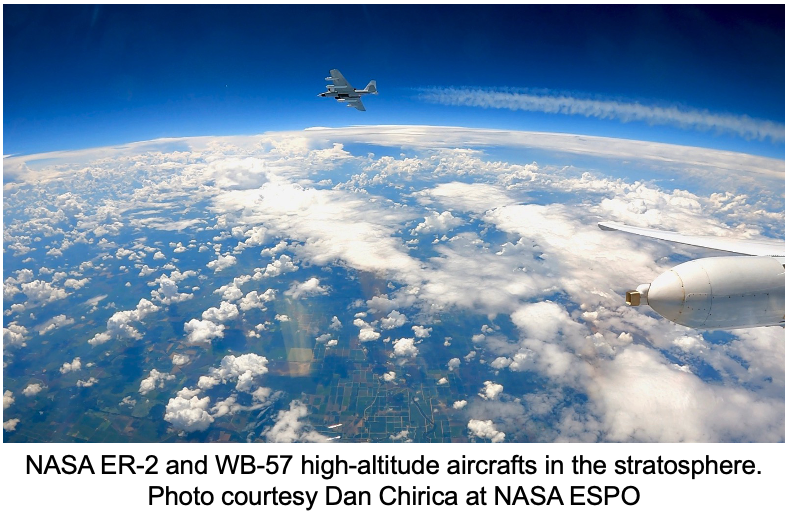
During the NASA DCOTSS and NOAA SABRE aircraft missions, I developed and deployed two aircraft instruments to: 1) measure UTLS aerosol concentration and size distribution (DPOPS instrument), and 2) collect UTLS aerosol samples for offline chemical composition and morphology analysis (high-altitude aircraft MOUDI system). My work yielded a valuable dataset of aerosol concentration, size distribution, composition, and morphology up to 22 km over North America. This dataset is essential for characterizing background UTLS aerosols and perturbations from volcanic and wildfire injections. For example, my instrument measured volcanic plumes from La Soufrière eruptions in April 2021 in the stratosphere, which I used for detailed analysis of their spatiotemporal evolutions and impacts on radiative forcing and ozone (Li et al., ACP, 2023). It also captured 5-day-old pyrocumulonimbus (pyroCb) smoke plumes in the UT, which exhibited an unusually large size mode (500-600 nm diameter) that substantially enhanced the radiative cooling effect of smoke aerosols (Li et al., preprint, 2024). Data from DCOTSS mission are publically available at NASA ASDC archive. Feel free to email me if you have any questions on the aerosol data.
2. Chemical imaging of UTLS aerosol samples
(In collaboration with Alex Laskin Group at Puerdue University; Swarup China and Zezhen Cheng at EMSL)
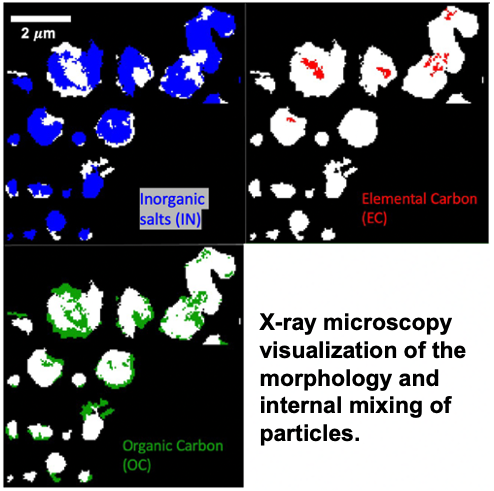
UTLS aerosol samples for offline chemical imaging analysis were collected by a cascade impactor (Mini-MOUDI 135, MSP) onboard the NASA ER-2 and WB-57 high-altitude research aircrafts. Preliminary analysis of DCOTSS samples revealed that organic-containing particles, especially organics from wildfire sources, are common in the summer stratosphere, highlighting the potential importance of halogen activation reactions on the organic surface. (Sharpe, Li et al., Environ. Sci.: Atmos., 2025)
3. Composition dependence of stratospheric aerosol radiative forcing
(In collaboration with Terry Deshler at CU Boulder)
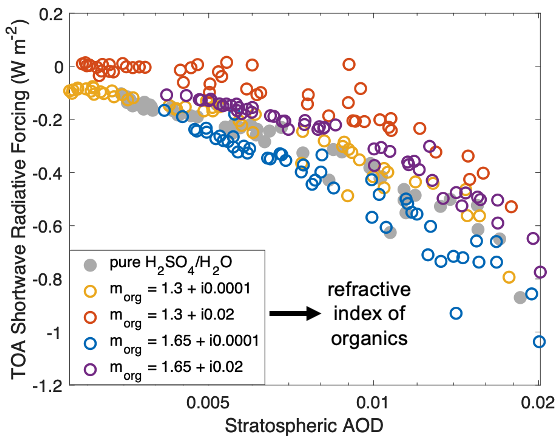
While it is generally assumed that stratospheric aerosol is dominated by pure sulfuric acid plus water aerosols, recent in situ measurements and modeling studies suggest that organic matter makes up a significant fraction of lower stratospheric aerosol. The implications of this organic component are uncertain but may require significant revision of our understanding of the stratosphere’s climate influence. I investigated the effects of the refractive index of organics and their mixing state with sulfate on shortwave radiative forcing (RF) of stratospheric aerosols. Using long-term balloon-borne aerosol measurement records and radiative transfer calculations, I found that organics may have significant impacts (up to 100% change) on stratospheric aerosol shortwave RF during periods of minimal-moderate volcanic activities. Currently, however, there is very little data on the mixing state and refractive index of organic-containing stratospheric aerosols. (Li et al., GRL, 2021)
4. Bridging chemical and optical properties of organic aerosols
(In collaboration with Pengfei Liu Group at Georgia Tech)
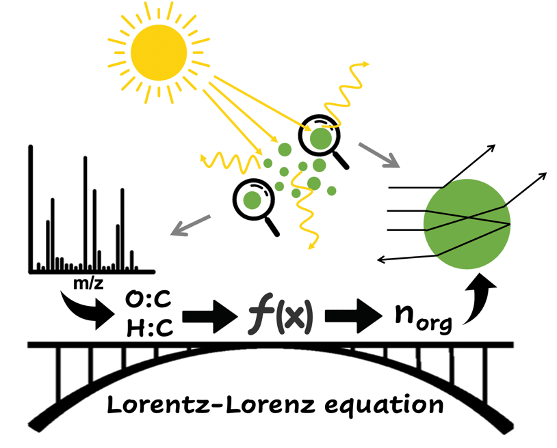
Accurate aerosol refractive index measurements are critical for modeling aerosol-radiation interaction, yet they are limited for ambient organic aerosols, leading to large uncertainties in estimating aerosol radiative effects. I developed a semiempirical model that predicts the real refractive index n of organic aerosol material from its widely measured oxygen-to-carbon (O:C) and hydrogen-to-carbon (H:C) elemental ratios. The model was based on the theoretical framework of Lorenz-Lorentz equation and trained with n-values at 589 nm (n_589nm) of 160 pure compounds. The predictions can be expanded to predict n-values in a wide spectrum between 300 and 1200 nm. The model was validated with newly measured and literature datasets of n-values for laboratory secondary organic aerosol (SOA) materials. Uncertainties of n_589nm predictions for all SOA samples are within ±5%. The model suggests that n_589nm-values of organic aerosols may vary within a relatively small range for typical O:C and H:C values observed in the atmosphere. (Li et al., GRL, 2023)
5. Copter-type UAV-based sensing in atmospheric chemistry
(In collaboration with Jianhuai Ye Group at SUSTech)
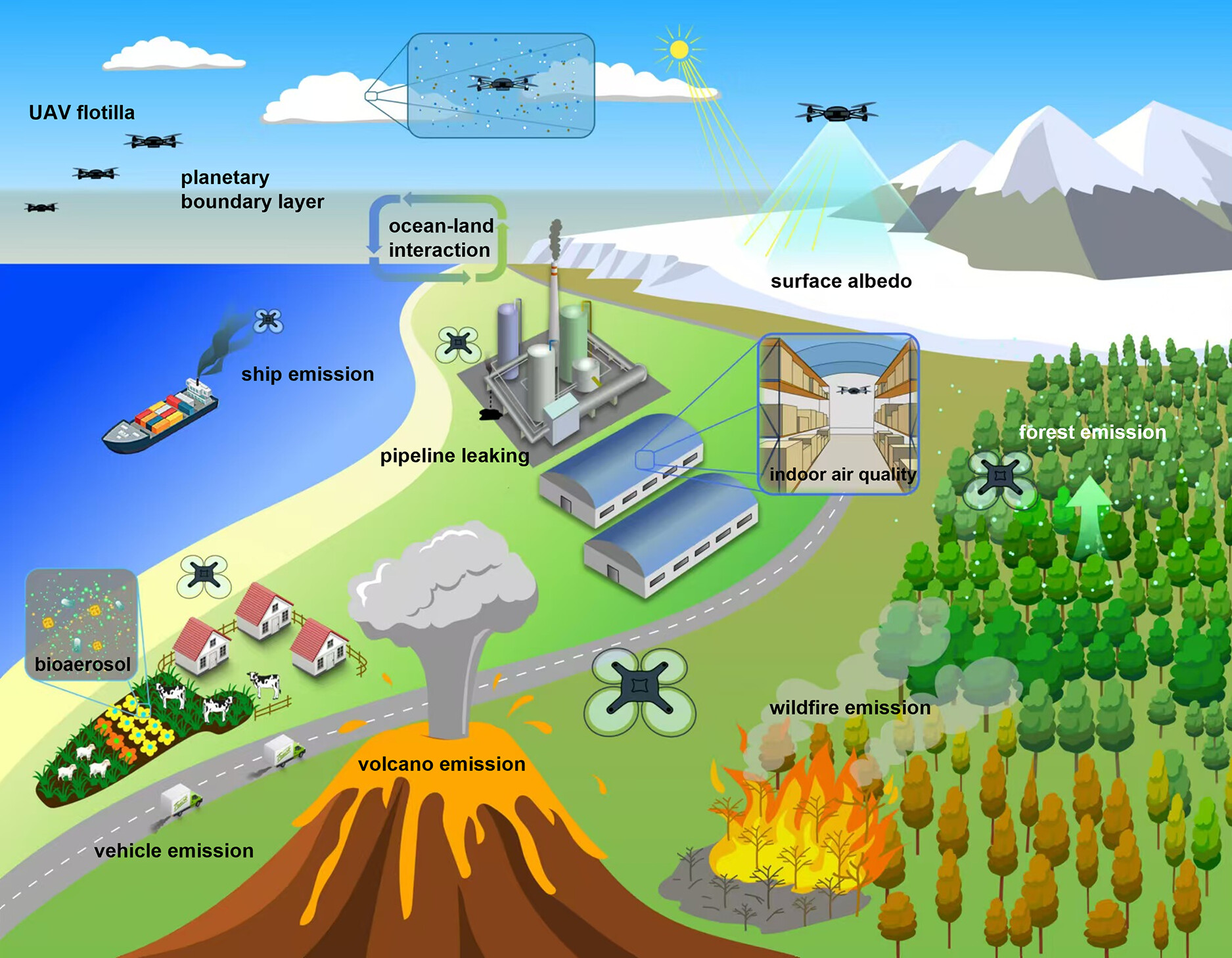
I led a recent review article (Li et al., ES&T, 2025) on copter-type unmanned aerial vehicles (UAVs), which have emerged as powerful, cost-effective platforms for atmospheric chemistry. The review highlights advances in UAV-based techniques for mapping gaseous pollutants using real-time, low-cost sensors and offline analytical methods, as well as profiling aerosol physicochemical properties to reveal their sources, transformations, and environmental impacts. We outlined diverse applications, including emission characterization (e.g., forest volatiles, bioaerosols), hazard assessment (e.g., wildfire and volcanic plumes), and meteorology and climate research (e.g., aerosol-cloud interactions), along with key challenges such as payload and battery limitations, regulatory constraints, and propeller-induced disturbances. We also explored emerging directions, from biosphere-atmosphere interactions to indoor air quality monitoring, underscoring how UAVs are reshaping atmospheric chemistry research by delivering high-resolution spatial data that complement traditional approaches.
6. Probing biosphere-atmosphere interactions with UAV-based sensing
(In collaboration with Qi Chen Group at PKU and Scot Martin Group at Harvard)
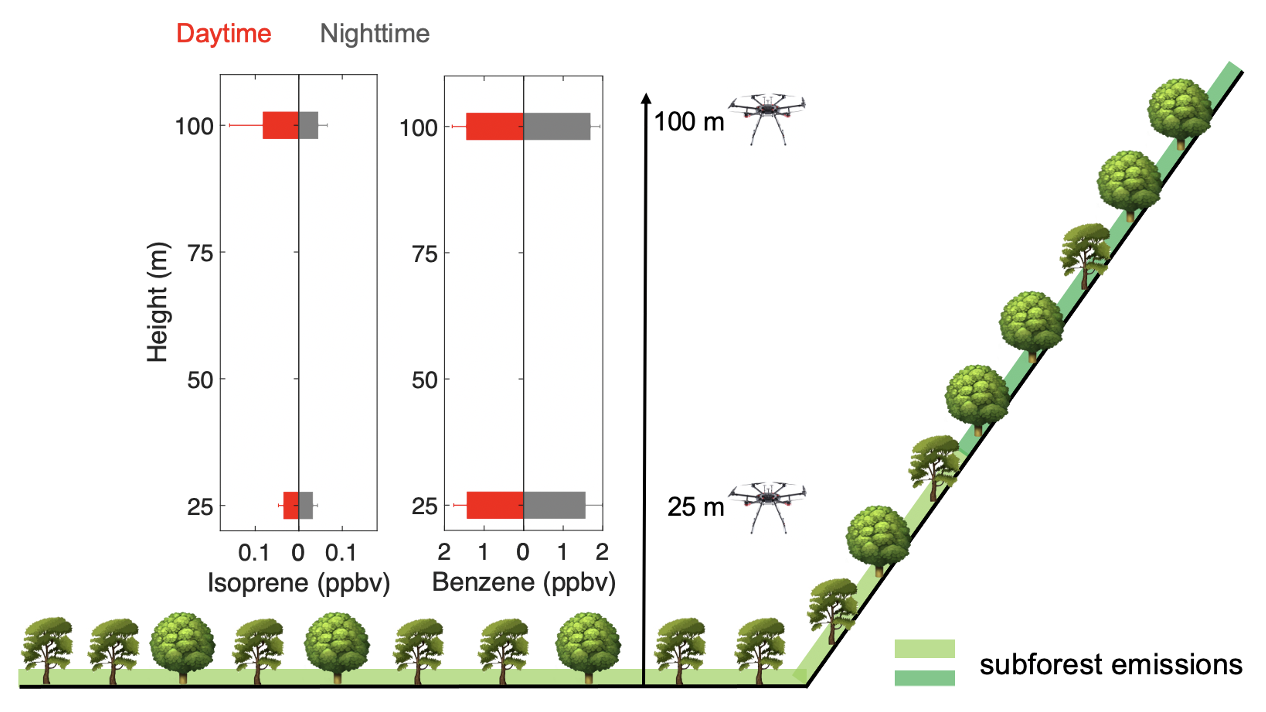
Volatile organic compounds (VOCs) are important air pollutants and play a critical role in biosphere-atmosphere interactions. Atmospheric sampling onboard a multicopter unmanned aerial vehicle (UAV), serving as an economical and flexible measurement technique, collects valuable VOC data at intermediate spatial scales of hundreds of meters. I developed an UAV-based VOC sampling apparatus. The sampler was deployed in a subtropical forest in South China to get vertical measurements of VOCs over the canopy. VOC samples were analyzed offline by thermal-desorption gas chromatography-mass spectrometry (TD-GC-MS). High aromatic VOCs concentrations and (methacrolein + methyl vinyl ketone) to isoprene ratios indicate a strong influence of anthropogenic pollution. Our measurements together with a gradient transport model suggested significant isoprene emission heterogeneity along the mountain slope at intermediate spatial scales, which has not yet been well represented in most biosphere emission models.(Li et al., ACS Earth and Space Chemistry, 2021)
7. Mass spectrometry of atmospheric reactive organic carbon
(In collaboration with Jesse Kroll Group at MIT)
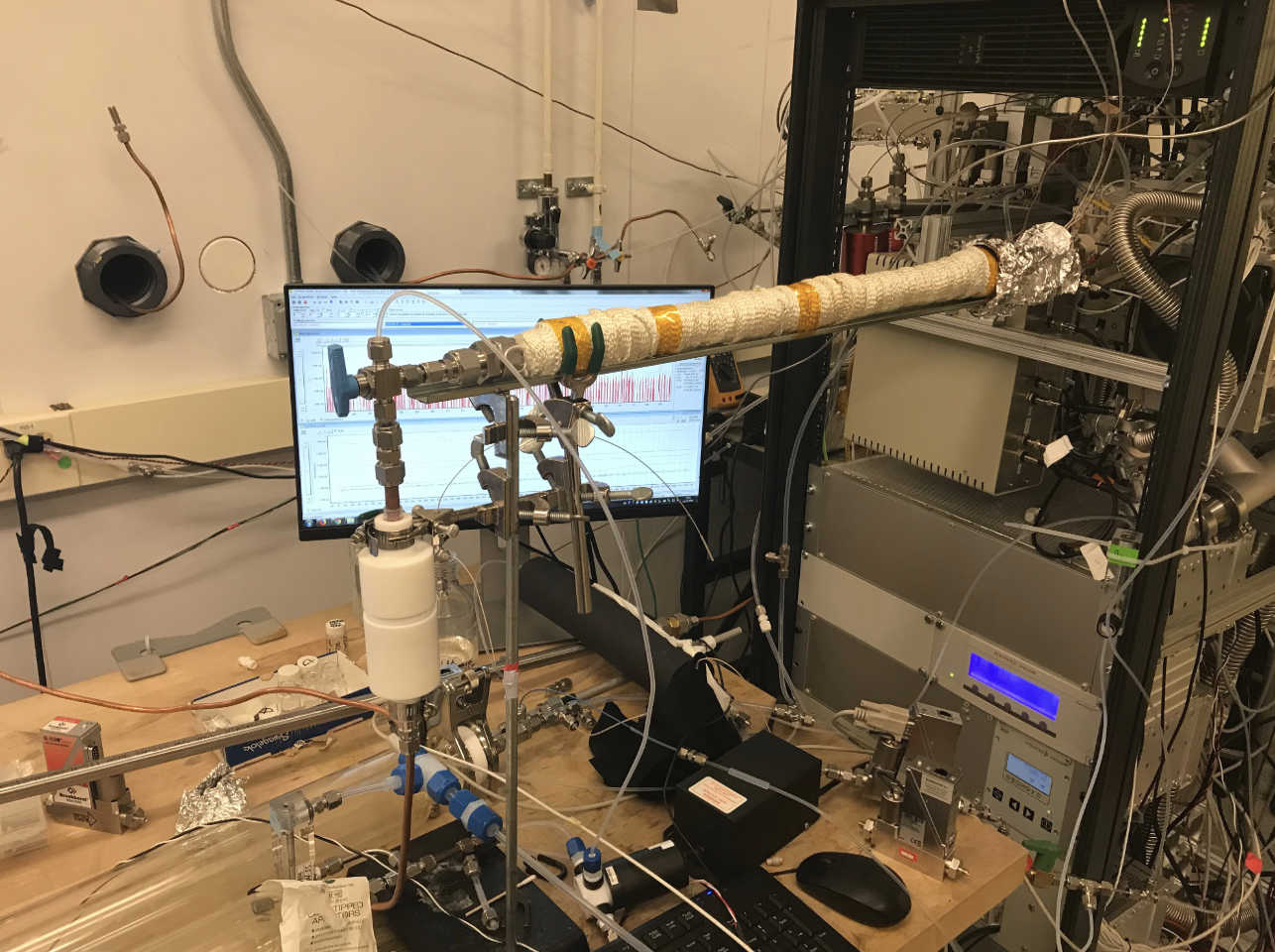
Reactive organic carbon (ROC) species are all atmospheric organic species excluding methane; this includes volatile organic compounds (VOCs) and other lower-volatility organics such as particulate organic carbon. Chemical ionization mass spectrometry (CIMS) is an important analytical tool for measurements of ROC in the atmosphere. I have been using and maintaining two Harvard CIMS instruments (aka PTR3) and participated in several laboratory and field projects with PTR3 instruments. Harvard PTR3 instruments can be operated in one of two ionization modes: using either proton transfer reactions such as for PTR-MS (Breitenlechner et al., 2017) or ammonium ion ligand-switching reactions such as for NH4+ CIMS (Zaytsev et al., 2019). Employment of the two ionization modes significantly improves the measurement capability of the instruments and allows for detection of a vast array of compounds covering a wide range of volatilities from VOCs to ELVOCs. In addition, the PTR3 instruments can be equipped with a thermal desorption inlet to quantify particle-phase compounds. I have extensively utilized PTR3 instruments for: (1) indoor air quality implications of oxidation-based air cleaners (Ye et al., ES&T Letters, 2021) and Germicidal 222 nm Light (Barber et al., ES&T, 2023); (2) chemistry of dimethyl sulfide (DMS) and its oxidation products in the atmosphere (Ye et al., ACP, 2022); (3) Munich Urban Air Quality Campaigns.
